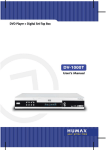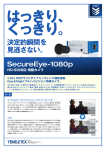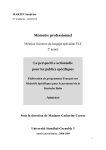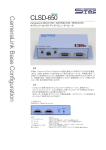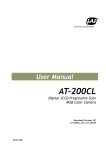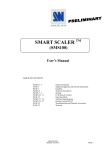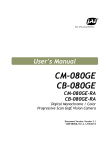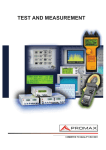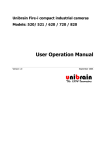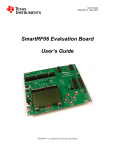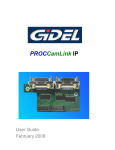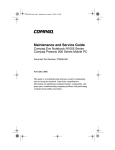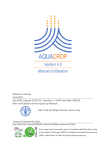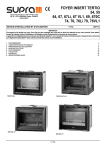Download JAI AD-080 CL Manual
Transcript
User's Manual AD-080CL Digital 2CCD Progressive Scan Multi-Spectral Camera Document Version: 1.2 AD-080CL_Ver.1.2_July2012 AD-080CL Supplement The following statement is related to the regulation on “ Measures for the Administration of the control of Pollution by Electronic Information Products “ , known as “ China RoHS “. The table shows contained Hazardous Substances in this camera. mark shows that the environment-friendly use period of contained Hazardous Substances is 15 years. 嶷勣廣吭並㍻ 嗤蕎嗤墾麗嵎賜圷殆兆各式根楚燕 功象嶄鯖繁酎慌才忽佚連恢匍何〆窮徨佚連恢瞳麟半陣崙砿尖一隈〇云恢瞳ゞ 嗤蕎嗤 墾麗嵎賜圷殆兆各式根楚燕 〃泌和 桟隠聞喘豚㍉ 窮徨佚連恢瞳嶄根嗤議嗤蕎嗤墾麗嵎賜圷殆壓屎械聞喘議訳周和音氏窟伏翌 亶賜融延、窮徨佚連恢瞳喘薩聞喘乎窮徨佚連恢瞳音氏斤桟廠夛撹冢嶷麟半 賜斤児繁附、夏恢夛撹冢嶷鱒墾議豚㍉。 方忖仝15々葎豚㍉15定。 AD-080CL Table of Contents 1. 2. 3. 4. 5. General .............................................................................................. 4 Camera nomenclature............................................................................. 4 Main Features ...................................................................................... 5 Locations and functions ........................................................................... 6 Pin configuration ................................................................................... 7 5.1 12-pin multi connector (DC in / Trigger in) .................................................. 7 5.2 Digital Output Connector (Camera LinkTM) .................................................... 7 5.3 Input and output circuits ........................................................................ 8 5.3.1 Iris Video output ............................................................................... 8 5.3.2 Trigger input.................................................................................... 8 5.3.3 XEEN (Exposure Enable) output .............................................................. 8 5.3.4 Camera Link Interface ........................................................................ 8 6. Third party products .............................................................................10 6.1 Lens considerations .............................................................................10 6.2 Frame grabber boards ..........................................................................10 7. Functions and operation .........................................................................11 7.1 Basic functions ...................................................................................11 7.1.1 2 CCD optical assembly ......................................................................11 7.1.2 Continuous operation or triggered operation .............................................12 7.1.3 Configuring the Camera Link interface ....................................................12 7.1.4 Digital Video output (Bit allocation) .......................................................13 7.1.5 Iris Video output ..............................................................................13 7.2 Auto-detect LVAL-sync / a-sync. accumulation .............................................13 7.2.1 Partial scan and Color Pixels layout ........................................................14 7.2.2 Electronic shutter (Commands SM1 and SM2, SH1 and SH2, PE1 and PE2) ...........15 7.2.3 Shading correction (Commands SDM1 and SDM2, RS1 and RS2) ........................15 7.2.4 Knee compensation (Commands KN1 and KN2) ...........................................15 7.2.5 White balance (Commands WB1, GA1, GAR1, GAB1, AW1, WA1) ......................16 Rear Panel Indicator ....................................................................................16 7.2.6 Test Signal Generator (Commands: PBY1,PBY2) .........................................17 7.2.7 Cross hair generator (Commands: CM1,CM2) .............................................17 7.3 Modes and functions matrix....................................................................17 7.4 Sensor Layout and Timing ......................................................................18 7.4.1 Sensor Layout..................................................................................18 7.4.2 Horizontal Timing .............................................................................19 7.4.3 Vertical Timing ................................................................................20 7.4.4 Partial Scan ....................................................................................20 7.5 Operation Mode ..................................................................................24 7.5.1 Continuous mode .............................................................................24 7.5.2 Pre-Select trigger mode .....................................................................24 7.5.3 Pulse Width trigger mode ....................................................................26 7.5.4 Smear-Less mode .............................................................................28 8. Configuring Camera...............................................................................29 8.1 Serial communication ...........................................................................29 8.2 Setting functions ................................................................................30 8.2.1 Output mode (Command IS) .................................................................30 8.2.2 Trigger input select (Command TI1 and TI2) .............................................30 8.2.3 Trigger mode (Command TR1 and TR2)....................................................30 8.2.4 Trigger polarity (Command TP1 and TP2) .................................................30 2 AD-080CL 8.2.5 Smear Less (Command SL1 and SL2) .......................................................30 8.2.6 Scan Format (Command SC1 and SC2) .....................................................30 8.2.7 Gain Master level (Command GA1 and GA2) ..............................................30 8.2.8 AGC select (Command AGC1 and AGC2) ...................................................30 8.2.9 Setup-Y (Command BLY1 and BLY 2) .......................................................30 8.3 Load and Save functions ........................................................................30 8.4 AD-080CL Command list .......................................................................31 8.5 .........................................................................................................31 9. AD-080CL Camera Control Tool ...............................................................36 9.1 Camera Control Tool Interface ................................................................36 9.1.1 Camera Control Tool Bar ....................................................................36 9.1.2 The About Window............................................................................36 9.1.3 Communication Window .....................................................................37 9.1.4 Common Control window ....................................................................38 9.1.5 Camera Control Window .....................................................................38 9.2 Using the Camera Control Tool ................................................................39 10. External Appearance and Dimensions ..........................................................40 11. Specifications......................................................................................41 11.1 Spectral response .............................................................................41 11.2 Specifications Table ..........................................................................42 12. Appendix ...........................................................................................44 12.1 Precautions ....................................................................................44 12.2 Typical Sensor Characteristics ..............................................................44 12.3 Caution when mounting a lens on the camera ...........................................44 12.4 Exportation ....................................................................................45 12.5 References .....................................................................................45 Revisions .....................................................................................................47 User's Record ...............................................................................................48 3 AD-080CL 1. General AD-080CL is a unique prism based 2CCD multi-spectral camera, combining a visible color channel (Bayer mosaic CCD) and a Near-IR channel (monochrome CCD). The major advantage of the AD-080CL is that it captures both channels simultaneously through the same optical path. This camera can be used for solving inspection tasks, where images from the visible (color) and near-infrared spectrum are required in combination. Typical applications include print inspection, fruit, vegetable & produce inspection, surface quality control, to mention only few. The AD-080 CL uses a standard Camera Link interface, whereby each channel can output images with 8 or 10-bit depth. The color channel can also output 24-bit RGB. 2. Camera nomenclature The standard camera composition consists of the camera main body and Sensor protection cap. The camera is available in the following version. AD-080 CL Where A stands for “Advanced family“ , D stands for “Dual CCD“, 080 represents the resolution “ 800K pixels” and CL stands for Camera LinkTM Interface. 4 AD-080CL 3. Main Features Multi-spectral 2-channel CCD camera Advanced series 2 x 1/3” progressive scan camera Simultaneously captures Visible and Near-IR through the same optical path 1024 (h) x 768 (v) active pixels per channel 4.65 μm square pixels 30 frames/second with full resolution Increased frame rate with partial scan Programmable exposure from 20μs to 33ms Pre-select and Pulse width trigger modes LVAL Synchronous/-asynchronous operation (auto-detect) Auto-iris lens video output allows a wider range of light RGB 24-bit or Raw Bayer 10 or 8-bit output for visible 10 or 8-bit output for Near-IR Setup by Windows NT/2000/XP via serial communication 5 AD-080CL 4. Locations and functions Lens Mount CCD Sensor 26P Multi Connector 26P Multi Connector 12P Multi Connector LED Push Button Mounting holes : : : : : : : : C-mount ( Note ) 1/3 inch CCD sensor Camera Link connector Output 1 Camera Link connector Output 2 DC+12V and Trigger Input Power and Trigger indications For Auto white balance M3, max length 5mm (Note) AD-080CL is based on a Dichroic Prism. For optimal performance, lenses designed for 3CCD cameras should be used with this camera. Rear protrusion of the C-mount lens must be less than 4mm to avoid damage to the prism. Fig.1. Locations 6 AD-080CL 5. Pin configuration 5.1 12-pin multi connector (DC in / Trigger in) Type: HR-10A-10R-12PB (Hirose) male. (Seen from rear of camera.) 9 1 2 8 10 11 3 4 7 12 5 6 Fig.2. 12-pin connector Pin No. 1 2 3 4 5 6 7 8 9 10 11 12 In / Out Name GND DC (+12V) in GND Iris Video GND XEEN 1 XEEN 2 GND O O O I I Trigger 1 Trigger 2 GND Remarks For Auto-Iris lens Negative Logic Channel 1 Channel 2 5.2 Digital Output Connector (Camera LinkTM) Type: 3M 10226-1A10JL Fig.3. 26-pin CameraLink connector Pin No 1,14 2(-),15(+) 3(-),16(+) 4(-),17(+) 5(-),18(+) 6(-),19(+) 7(+),20(-) 8(-),21(+) 9(-),22(+) 10(+),23(-) 11,24 12,25 13,26 CameraLink Connector 1 In/Out O O O O O I O I CameraLink Connector 2 Name Shield TxOUT0 TxOUT1 TxOUT2 TxClk TxOUT3 SerTC (RxD) SerTFG (TxD) CC1 (Trigger) N.C N.C N.C Shield In/Out O O O O O I O I 7 Name Shield TxOUT0 TxOUT1 TxOUT2 TxClk TxOUT3 SerTC (RxD) SerTFG (TxD) CC1 (Trigger) N.C N.C N.C Shield Remarks GND Data output Clock for CL Data output LVDS serial control Ext.trigger IN GND AD-080CL 5.3 Input and output circuits In the following schematic diagrams the input and output circuits for video and timing signals are shown. 5.3.1 Iris Video output This signal can be used for lens iris control in Continuous mode. The signal is taken from the CCD sensor output before the gain circuit. The video output is without sync. The signal is 0.7 V p-p from 75 without termination. 75 GND Fig.4. 5.3.2 Trigger input An external trigger input can be applied to pin 10 and 11 of 12-pin Hirose connector (when the command TI1=1 or TI2=1 has been set). The input is AC coupled. To allow long pulses the input circuit is designed as a flip-flop circuit. The leading and trailing edges of the trigger pulse activate the circuit. The trigger polarity can be changed by TP1/TP2=1. Trigger input level 4 V 2 V. Trigger can also be applied through the Camera Link connector, when the command TI1/TI2=0 have been sent. 5.3.3 XEEN (Exposure Enable) output XEEN is available on pins 6 and 7 of the 12-pin Hirose connector. The output circuit is 75 complementary emitter followers. It will deliver a full 5 volt signal. Output level 4 V from 75. (No termination). EEN is also found in Camera Link. Video Output Trig input pin #10 & #11 Iris video circuit +5V 15k 1k 100n 75Ω 68k TTL 100k SW302.1 1k 1n GND Fig.5. Trigger circuit +5V TTL 5.3.4 Camera Link Interface The video output can be configured as follows: Visible (color) channel: 10/8-bit raw Bayer or 24 bit-RGB color Near-IR channel: 10/8-bit for Near-IR channel. They are both output via a standard Camera Link interface. 100 2k2 10k 2 2 75 Pin #6 & #7 XEEN output GND Fig.6. XEEN output circuit The pin configuration of 26-pin connector conforms to Camera Link BASE configuration. However, since AD-080CL camera can be set for various configurations, the Camera Link assignment will vary depending on specific settings. Please refer the below table for details. 8 GND AD-080CL Camera Link Output Connector 1 Port/ Signal Port A0 Port A1 Port A2 Port A3 Port A4 Port A5 Port A6 Port A7 Port B0 Port B1 Port B2 Port B3 Port B4 Port B5 Port B6 Port B7 Port C0 Port C1 Port C2 Port C3 Port C4 Port C5 Port C6 Port C7 LVAL FVAL DVAL E E N Bayer 10-bit D0 D1 D2 D3 D4 D5 D6 D7 D8 D9 × × × × × × × × × × × × × × Bayer Bayer 10-bit / 8-bit Near-IR 10-bit * Note D0 D1 D2 D3 D4 D5 D6 D7 × × × × × × × × × × × × × × × × D0 D1 D2 D3 D4 D5 D6 D7 D8 D9 × × NIR_D8 NIR_D9 × × NIR_D0 NIR_D1 NIR_D2 NIR_D3 NIR_D4 NIR_D5 NIR_D6 NIR_D7 Camera Link Output Connector 2 Bayer Near-IR 8-bit / 10-bit/ RGB Near-IR Near-IR Near-IR Bayer 24-bit 10-bit 8-bit 8-bit 10-bit * Note * Note Near-IR 8-bit / RGB Bayer 24-bit 8-bit * Note D0 D1 D2 D3 D4 D5 D6 D7 NIR_D0 NIR_D1 NIR_D2 NIR_D3 NIR_D4 NIR_D5 NIR_D6 NIR_D7 × × × × × × × × NIR_D0 NIR_D1 NIR_D2 NIR_D3 NIR_D4 NIR_D5 NIR_D6 NIR_D7 D0 D1 D2 D3 D4 D5 D6 D7 RD0 RD1 RD2 RD3 RD4 RD5 RD6 RD7 GD0 GD1 GD2 GD3 GD4 GD5 GD6 GD7 BD0 BD1 BD2 BD3 BD4 BD5 BD6 BD7 NIR_D0 NIR_D1 NIR_D2 NIR_D3 NIR_D4 NIR_D5 NIR_D6 NIR_D7 NIR_D8 NIR_D9 × × × × × × × × × × × × × × NIR_D0 NIR_D1 NIR_D2 NIR_D3 NIR_D4 NIR_D5 NIR_D6 NIR_D7 × × × × × × × × × × × × × × × × NIR_D0 NIR_D1 NIR_D2 NIR_D3 NIR_D4 NIR_D5 NIR_D6 NIR_D7 NIR_D8 NIR_D9 × × D8 D9 × × D0 D1 D2 D3 D4 D5 D6 D7 RD0 RD1 RD2 RD3 RD4 RD5 RD6 RD7 GD0 GD1 GD2 GD3 GD4 GD5 GD6 GD7 BD0 BD1 BD2 BD3 BD4 BD5 BD6 BD7 Pin No. Tx0 Tx1 Tx2 Tx3 Tx4 Tx6 Tx27 Tx5 Tx7 Tx8 Tx9 Tx12 Tx13 Tx14 Tx10 Tx11 Tx15 Tx18 Tx19 Tx20 Tx21 Tx22 Tx16 Tx17 Tx24 Tx25 Tx26 Tx23 *Note When the output mode is set at “Separate”, only one channel signal is output. For instance, if “BAYER 10 bit/ IR 10 bit” is selected on channel 1, only “ Bayer 10 bit” is output when the output mode is set at “ Separate “. Command “IS” is related to this . IS=0 Synchronous and IS=1 Separate 9 AD-080CL 6. Third party products 6.1 Lens considerations The AD-080CL is based on a dichroic prism, allowing precise separation of the visible (color) and Near-Infrared parts of the spectrum. Thanks to the compact design of the prism C-mount lenses can be used with this camera. For optimal performance it is strongly advised to use lenses designed for 3CCD cameras with the AD-080CL. These lenses have minimal chromatic aberration, thus allowing both the Visible and Near-IR images to be in focus. Visible area Focus point NIR area Focus Point Fig 7. focal points for Visible and NIR lights 6.2 Frame grabber boards AD-080CL has two Camera Link connectors. It is possible to operate the camera with just a single Camera Link connector when the camera is set to “Synchronous” mode. i.e. when both Channels are operating synchronously. In addition, the output from Channel 1 (Visible, color) must be set to raw Bayer 8- or 10-bit and Channel 2 (Near-IR) must be set to 8- or 10-bit. Chapter 7.1.2 describes how the Camera Link outputs cam be configured. If the two channels are set to operate “Separate”, the two channels act as two individual cameras. Therefore a frame grabber with Dual Base configuration must be used. Alternatively two separate frame grabbers must be use. When Channel 1 is set to output RGB 24-bit images, a Dual Base frame grabber must also be used. In this case the RGB 24-bit image is normally configured to come of on Camera Link connector 1 and the Near-IR channel is set to come out on Camera Link connector 2. 10 AD-080CL 7. Functions and operation 7.1 Basic functions The AD-080CL is based on a dichroic prism, allowing precise separation of the visible (color) and Near-Infrared parts of the spectrum into two separate channels. The Visible (color) channel is referred to as Channel 1 and the Near-Infrared channel is referred to as Channel 2. Channel 1 and 2 can be configured to operate separately or synchronously. When operating separately each channel can be triggered and read out independently. The AD-080CL can operate in Continuous (free-run) mode or in the Pre-Select (PS) and Pulse Width (PW) trigger modes. The Partial Scan function, with 1/2, 1/4 or 1/8 image height, provides higher frame rate at lower vertical resolution. 7.1.1 2 CCD optical assembly The dichroic prism incorporated in the AD-080CL separates the visible (color) part of the spectrum into a wavelength band from 400nm to 650nm (Channel 1) and the Near-IR part into a band ranging from 760 nm to 1000 nm (Channel 2). The below figure shows the concept of the separation into Visible and Near-IR bands. Visible light Channel 1 Imager 2 Near-IR Channel 2 Fig 8. Conceptual diagram for 2CCD prism optics 11 AD-080CL 7.1.2 Continuous operation or triggered operation The camera can operate in continuous operation to support applications not requiring asynchronous external trigger. This mode permits the use of a lens with video controlled iris. The signal from Channel 1 is used for this purpose. The camera will operate at its maximum frame rate, 30 frames/seconds in this mode. The command TR1=0 (Channel 1) and TR2=0 (Channel 2) are used to enable Continuous operation. To use the camera with external asynchronous trigger signals the trigger mode must be set accordingly. Setting the Command TR1=1 or TR2=1 enables the Pre-Select (PS) trigger mode. Here the exposure time is pre-defined by the Preset Shutter (commands SH1 and SH2) or the Programmable Exposure (commands PE1 or PE2). The command TR1=2 or TR2=2 enables the Pulse Width (PW) trigger mode, whereby the length of the trigger pulse controls the exposure time. The external trigger signal can be applied to the 12-pin Hirose connector (pin 10 for Channel 1 and pin 11 for Channel 2) or via the Camera Link interface. The 12-pin Hirose input trigger input is factory default. The input termination for the Hirose 12-pin trigger inputs can be changed from TTL (high impedance) to 75Ω by the internal switch SW802. The below diagram shows where the switch is located and how it is set. SW 80 2 2 1 N O 75Ω TTL Trig.1 Trig.2 Fig.9. Switch SW802 location and setting By using the command “TI” the trigger input can be configured to Camera Link. When this is selected, the trigger inputs of both Camera Link connectors can be used. The next chapter describes the configuration of inputs and outputs of the Camera Link interface. 7.1.3 Configuring the Camera Link interface The AD-080CL has two Camera Link connectors. These two outputs can be synchronized or used separately by setting the command “IS”. Each connector can output an individual channel or a combination of two channels as shown in the table below. In order to output two channels through one Camera Link connector, the output mode must be set to “synchronous”, command IS=0. If the channels are to be output on individual channels the output mode must be set to “Separate”, command IS=1. The command “OS” selects the output format of the two channels. Please note that not all combinations can operate in Separate mode. 12 AD-080CL Output mode IS=0 or 1 Sync/Separate Sync/Separate Sync Sync Sync/Separate Cmd. Camera Link 1 Output format OS1=0 OS1=1 OS1=2 OS1=3 OS1=4 BAYER 10-bit BAYER 8-bit BAYER+NIR 10-bit BAYER+IR 8-bit RGB 24-bit Default Cmd. Camera Link 2 Output format ● OS2=0 OS2=1 OS2=2 OS2=3 OS2=4 IR 10-bit IR 8-bit IR+BAYER 10-bit IR+BAYER 8-bit RGB 24-bit Default ● In Synchronous mode (IS=0), Trigger 1 activates both channels (and Trigger 2 is not valid). Trigger signals can be input either via the Camera Link interface or as TTL signals at the 12-pin Hirose connector. 1023 7.1.4 Digital Video output (Bit allocation) The 10-bit digital output is set at 890 LSB as 100% video level when CCD output is 200mV. The white clip level is set at 1023 LSB when CCD output is 230mV. White Clip Level 100% Level Digital Out [LSB] 890 When using the 8-bit output, the equivalent settings are 222 LSB and 255 LSB respectively. 32 0 Black Level 25 Analog Signal [mV] 700 800 Fig.10. Digital Video Output 930 700 100% Level Analog Out [mV] 7.1.5 Iris Video output The lens-iris video output level at pin 4 of the 12-pin Hirose connector is 700 mV for 100% video output level in Camera Link. The iris video signal is taken before the gain circuit. It is without sync. The iris video signal can be used for auto-iris lens drive in continuous mode. 0 CCD Out [mV] 200 265 Fig.11. Iris Video output 7.2 Auto-detect LVAL-sync / a-sync. accumulation This function replaces the manual setting found in older JAI cameras. Whether accumulation is synchronous or a-synchronous in relationship to LVAL depends on the timing of the trigger input. When a trigger is received while FVAL is high (during readout), the camera works in LVAL-synchronous mode, preventing reset feed-through in the video signal. There is a maximum jitter of one LVAL period from issuing a trigger to accumulation start. 13 AD-080CL When and external trigger is received during FVAL low, the cameras works in LVAL-asynchronous (no delay) mode. This applies to both Pre-Select (PS) trigger and Pulse Width trigger (PW) modes. Ext. trigger (1) (2) (3) FVAL (1) In this period camera executes trigger at next LVAL (prevents feed-through noise) (2) Avoid trigger at FVAL transition (+/- 1 LVAL period), as the function may randomly switch between "next LVAL" and "immediate". (3) In this period camera executes trigger immediately (no delay) 7.2.1 Partial scanFig. and12. Color Pixels layout Auto-detect LVAL sync /a-sync accumulation Partial scan allows higher frame rates by reading out a smaller center portion of the image, reducing vertical resolution. This is particularly useful when inspecting objects that do not fill the whole height of the image. Fast-dump period Normal scan period Fast-dump period Full scan Partial Scan Channel 1 of the AD-080CL uses a Bayer mosaic color CCD sensor. The color image reconstruction is done in the host PC when the camera is configured for raw Bayer output. The color sequence in the video signal is the same for all partial scan format, i.e. BG. The right hand drawing shows the color sequence at the image start. The starting line number is shown from FVAL. The first active pixel is offset 8 pixels from LVAL, when DVAL rises. Channel 1 can also be configured to output 24-bit RGB video. Even lines starts with GRG. Odd lines starts with BGB. FVAL Timing Line # from FVAL triming Actual V Line # 1 13 1 B G B G R G Full 55 193 B G B G R G 1/2 Partial 79 289 B G B G R G 1/4 Partial 91 337 B G B G R G 1/8 Partial LVAL DVAL 1 OB(3) Reserve(5) Fig.13. Bayer color mosaic 14 AD-080CL 7.2.2 Electronic shutter (Commands SM1 and SM2, SH1 and SH2, PE1 and PE2) When Shutter Mode (SM) is set 1, the Pre-Select function is enabled. This allows a fixed shutter to be set either by the Pre-set shutter (SH) or by the Programmable Exposure (PE). Pre-set Shutter (SH) The range of settings is from SH=0(OFF) to SH=11 (1/50,000) OFF(1/30); 1/60; 1/100; 1/120; 1/250; 1/500; 1/1000; 1/2,000; 1/4,000; 1/10,000; 1/16,000; 1/50,000 Programmable Exposure (PE) Exposure time can be controlled in 1 LVAL unit (42.07µs). The range is from 0.5LVAL to 792LVAL. The actual shutter speed for each operation mode is shown below. Mode Continuous, Pre-Select Pulse Width Note: Read Out Full, Partial Minimum shutter speed 20µs at PE=0 (1/50,000) Maximum shutter speed 1 Frame Full, Partial 42.07µs x 1L+42.07µs x 0.5L= 60 Frames (2 seconds) 63.1µs (approx. 1/16,000s) In Pulse Width mode, the minimum trigger pulse width must be >2LVAL. 7.2.3 Shading correction (Commands SDM1 and SDM2, RS1 and RS2) The AD-080CL features a shading correction circuit that can be used for reducing shading resulting from illumination, lens vignetting or prism shading caused by lenses with a wide output aperture. The shading correction circuit divides the image up into 128 horizontal and 96 vertical fields, and adjusts these regions in relationship to the image center. Each channel is treated handled separately by the commands SDM1 and SMD2 (turns shading correction on and off). To set (calibrate) the shading correction, the commands RS1 and RS2 are used. The shading correction works with all output formats, raw Bayer color, Near-IR and 24-bit RGB. 1335 1023 968 Output Camera Link Data Level 7.2.4 Knee compensation (Commands KN1 and KN2) 890 1/16 The camera operates internally with 12-bit Knee Point digitization, resulting in a dynamic range of 1335 LSB. The output can be selected as 8- or 10-bit whereby Knee Point = 37Ah (890) the data over 1023 LSB is clipped to provide linear Knee Slope = 080h (1/16) In this case : Maximum Value is 968 LSB. relationship between the input (CCD signal) and the 32 output (Camera Link). 0 0 102 4095 2848 The Knee compensation circuit, featuring Knee Input CCD Data Level Point and Knee Slope settings, makes it possible to map the data up to 1335 LSB into the 8-bit or 10-bit Fig. 14. Knee characteristics (Default setting) output. The right drawing shows the characteristics for factory default. The Knee compensation can be used together with the RGB 24-bit or Monochrome 8- or 10-bit output. 15 [100%] [0%] AD-080CL 7.2.5 White balance (Commands WB1, GA1, GAR1, GAB1, AW1, WA1) When using the RGB 24-bit output mode, the white balance function is available. It can be used in 4 ways: 1) Continuous (tracking) Automatic White Balance, AWB 2) One-push AWB (rear panel push-button or command AW1=0) 3) Manual white balance setting, and 4) Pre-set white balance of 3,200K, 4000K, 4600K and 5600K. Command: WB1=0 Manual or One-push white balance WB1=1 Continuous (tracking) AWB WB1=2 4,000K WB1=3 4,600K WB1=4 5,600K WB1=5 3,200K Manual white balance is achieved by optimizing the manual gain settings GA1, GAR1 and GAR2. Items Continuous (tracking) AWB(1) One-push AWB(2) Manual WB Adjusting range -3dB to +6dB -3dB to +6dB -3dB to +6dB Activated by the user No Yes No on the camera Possibility to store WB No Yes Yes settings Note 1: When using Continuous AWB, results depend on the surface properties of the object. Note 2: One-push AWB may take up to 3 seconds to complete. White Balance Measuring area The user can select which part of the image is used for White Balance measurement. The command WA1 is used for this. The 9 different settings are as follows: 0 1 2 3 4 5 6 7 8 9 : Full area : Upper Left : Upper Center : Upper Right : Center Left : Center : Center Right : Lower Left : Lower Center : Lower Right 0 1 3 7 9 4 6 Rear Panel Indicator The rear panel mounted LED provides the following information: Amber Steady green Flashing green : Power connected - initiating : Camera is operating in Continuous mode : The camera is receiving external trigger 16 2 8 5 AD-080CL 7.2.6 Test Signal Generator (Commands: PBY1,PBY2) The AD-080CL has a built-in test pattern generator. The test patterns can be enabled by these se commands: PBY1 for Visible (color) channel, imager 1: 0= Off, 1= Gradient, 2= Color Bar(1) PBY2 for Near-IR channel, imager 2: 0= Off, 1= Gradient, 2= 100% White Note 1: This test signal is available only when the RGB 24-bit output is selected on the Visible (color channel). 7.2.7 Cross hair generator (Commands: CM1,CM2) AD-080CL has a built-in cross hair generator for each channel. It can be configured to display a Vertical line, a Horizontal line or a combination of both lines. 1 = Vertical 2 = Horizontal 3 = Both 7.3 Modes and functions matrix AD-080CL has two output modes for each channel output. One is “Synchronous” mode and the other is “Separate” mode. On the Synchronous mode, two Camera Link output is synchronized each other and on the Separate mode, two Camera Link outputs are separately output. The following table shows modes and functions matrix. Color Imager (Channel 1) Output mode, “IS” IS=0 Operation TR Mode 0 1 Sync 2 IS=1 0 1 Separate 2 Cont. PS PW Cont. PS PW Near-IR imager (Channel 2) Trig. IN 1 Shutter Partial Smear Less TRIG. IN 2 Shutter Partial Smear Less Auto Iris No Yes Yes No Yes Yes Yes Yes No Yes Yes No Yes Yes Yes Yes Yes Yes No Yes Yes No Yes Yes No No No Yes Yes Yes Yes Yes No Yes Yes No Yes Yes Yes No No Yes Yes Yes(1) Legend: means that this channel (Channel 1) uses the Channel 1 settings Note (1) The analogue output for Auto iris is the signal from the color imager. 17 Yes(1) AD-080CL 7.4 Sensor Layout and Timing 7.4.1 Sensor Layout The CCD sensor layout, with respect to vertical and horizontal pixels used in full frame read-out, is shown below. For Bayer color sequence, refer to chapter 7.2.1. Blank 1077 4 2 Optical Black Lines Reserved Lines 6 Active Pixels 1024(H) x 768(V) 792 768 Reserved Lines 5 7 Optical Black Lines 1420 Clock 3 5 5 1024 40 343 Blank Read Out (Horizontal) Fig.15. Sensor layout and video output image 18 Read Out (Vertical) AD-080CL 7.4.2 Horizontal Timing The horizontal timing for continuous mode, full frame and partial scan are shown below. This is the common for both Bayer color imager and Monochrome IR imager. 1 LVAL 148 1ck = 33.750MHz (29.63ns/ck) period 1420ck 1077ck 343ck LVAL FVAL Raising Edge FVAL Falling Edge FVAL 1328ck 92 103ck SUB (20us) 590ck 86 SG 676ck Exposure Period 1 1ck EEN XEEN (Hirose 12pin) 8ck OB Reserved 3ck5ck DATA 45ck Effective Pixels 1024ck Reserved OB 5ck 40ck Dummy+ Blank 343ck OUT DVAL 29ck CCD Out 1024ck 1077ck 29ck 343ck 1CLK: 1 Pixel clock period OB: Optical black LVAL is HIGH in the period of optical black and effective video periods DVAL is HIGH in the effective video period Fig.16. Horizontal Timing 19 3 c k5 c k AD-080CL 7.4.3 Vertical Timing The vertical timing for continuous mode and full frame scan are shown below. This is the common for both Bayer color imager and Monochrome IR imager. 1L = 1420Clock (42.07us) 1 FVAL period FVAL 792L 4L 788L LVAL FVAL LVAL SUB SG Exposure Period 0.5L EEN XEEN e r v e d (Hirose 12pin) DATA OUT 5L Reserved OB Blank 6L 2L 4L 76 764 765 766 767 8 e s Effective Lines 768L R OB 7L 1 2 3 4 5 DVAL 1L : 1 LVAL period OB: optical black FVAL is HIGH in the optical black and effective video periods LVAL is always output DVAL is output during the effective lines Note: In case of the RGB24bit output, the output timing is delayed by 1 LVAL as comparing to Bayer and IR outputs. Fig.17. Vertical Timing 7.4.4 Partial Scan The vertical timing for continuous mode and partial scan is shown below. The horizontal timing for partial scan is the same as full scan. This is the common for Channel 1 (Visible, color) and Channel 2 (Near-IR) 20 AD-080CL SC Option Start End (Line) (Line) Line No. (Lines) 0 Full Screen 1 768 768 1 1/2 Screen 193 576 384 2 1/4 Screen 289 480 192 3 1/8 Screen 337 432 96 Back Blank Front of of of Frame Frame Frame -A-B-C- Output Image Full Frame Partial Scan 12 8 4 54 50 4 78 74 4 90 86 4 Vertical Timing for 1/2 Partial scan 1L= 1420Clock (42.07us) 492L 488L 4L FVAL LVAL High Speed Front of Frame Back of Frame Transfer SUB SG Exposure 0.5L Period EEN a Effective Lines 1 384L 1 2 3 4 5 DATA OUT Dummy DVAL 1L : 1LVAL period OB: Optical Black Fig.18. Vertical Timing for 1/2 Partial scan 21 50L (1/2) B 4L C Bl OB 38 380 381 382 383 4 3L 54L A 50L (1/2) nk XEEN (Hirose 12pin) AD-080CL Vertical Timing for 1/4 Partial scan 1 FVAL 1Line = 1420Clock (42.07us) period 348L 344L 4L FVAL LVAL High Speed Transfer Front of Frame Back of Frame SUB SG Exposure 0.5L Period EEN XEEN (Hirose 12pin) 74L 1 192L 74L 4L 18 188 199 190 191 2 OB B l a nk Effective Lines 78L 3L 1 2 3 4 5 DATA OUT Dummy DVAL Fig.19. Vertical Timing for 1/4 partial scan Vertical Timing for 1/8 Partial scan 1 FVAL 1Line = 1420Clock (42.07us) period 276L 272L 4L FVAL LVAL High Speed Front of Frame Back of Frame Transfer SUB SG Exposure 0.5L Period EEN XEEN 1 2 3 4 5 n 86L DATA OUT DVAL Fig.20. Vertical Timing for 1/8 Partial scan 22 4L la Effective Lines 96L 1 B 90L 86L 92 93 94 95 96 3L OB k (Hirose 12pin) AD-080CL Horizontal Timing (Common for Full and Partial Scans) 1 LVAL 148 1ck = 33.750MHz (29.63ns/ck) period 1420ck 1077ck 343ck LVAL FVAL Raising Edge FVAL Falling Edge FVAL 1328ck 92 103ck SUB (20us) 590ck 86 SG 676ck Exposure Period 1 1ck EEN XEEN (Hirose 12pin) 8ck OB Reserved 3ck5ck DATA 45ck Reserved OB 5ck 40ck Effective Pixels 1024ck Dummy+ Blank 343ck OUT DVAL 29ck CCD Out 1024ck 1077ck 29ck 343ck Fig.21. Horizontal Timing 23 3 c k5 c k AD-080CL 7.5 Operation Mode AD-080CL has three operation modes. 1 2 3 TR=0 TR=1 TR=2 Continuous Pre-Select Trigger Pulse Width Trigger Pre-selected exposure Pre-selected exposure Pulse width controlled exposure 7.5.1 Continuous mode For applications not requiring asynchronous external trigger, but should run in continuous operation, this mode is used. For timing details, refer to fig. 16 through fig. 21. To use this mode: Mode Trigger Output mode Output Select Scanning Shutter Preset Shutter Programmable Shutter Other functions Setting Continuous Sync/Separate 8-bit, 10-bit, Bayer, IR, Single Multiple, RGB 24-bit Full/Partial Preset / Programmable Shutter speed Shutter speed ( 1L unit) Command TR1/TR2=0 IS=0 (Sync), IS=1 (Separate) OS1/OS2=0 to 4 SC1/SC2=0 to 3 SM1/SM2=0, 1 SH1/SH2=0 to 10 PE1/PE2=0 to 792 7.5.2 Pre-Select trigger mode An external trigger pulse initiates the capture, and the exposure time (accumulation time) is defined by the SH or PE commands. The resulting video signal will start to be read out after the selected shutter time. For timing details, refer to fig. 16 through fig. 22. To use this mode: Mode Setting Trigger Edge Pre-select (PS) Output mode Sync/Separate Output Select 8-bit, 10-bit, Bayer, IR, Single Multiple, RGB 24-bit Scanning Full/Partial Shutter Preset / Programmable Preset Shutter Shutter speed Programmable Shutter Shutter speed (1L unit) Other functions Trigger Input Camera Link / Hirose 12-pin 24 Command TR1/TR2=1 IS=0 (Sync), IS=1 (Separate) OS1/OS2=0 to 4 SC1/SC2 = 0 to 3 SM1/SM2=0, 1 SH1/SH2=0 to 10 PE1/PE2=0 to 792 TI1/TI2=0, 1 AD-080CL Important Note: 1 The minimum duration of the trigger is 2L. The minimum period of trigger is as follows. Imager 1&2 Smear-less OFF FVAL(792L) + 3L Synchronized, Smear-less ON Smear-less Time(198L)+1+ ( longer exposure time IS=0 between color and IR) + FVAL(792L) + 3L Image 1&2 Smear-less OFF FVAL(792L) + 3L Separate, IS=1 Smear-less ON Smear-less Time(198L)+1+FVAL(792L)+3L FVAL(792L) is the FVAL period of continuous operation. 2 In case that “Output mode” is set to “SYNC”, the trigger input for Channel 1 is used for both channels. The exposure time can be set individually, but the output timing is synchronized with the rising edge of the longest exposure time. 1L: 1LVALPeriod OB : Optical Black Note for setting Exposure Time For instance, in case that the exposure time for color channel is 1/30 sec and that of Monochrome IR channel is 1/50,000 sec, the picture quality of the monochrome IR channel may not be acceptable due to CCD‟s operational principle. Accordingly, on EPS mode, each channel‟s exposure time should be set at the same. If it is necessary to set the different exposure time, please confirm the picture quality in advance of usage. Fig.22. Edge Pre-select Trigger Mode Timing ( Full scan ) 25 AD-080CL 7.5.3 Pulse Width trigger mode In this mode the accumulation time is equal the trigger pulse width. Here it is possible to have long time exposure. The maximum recommended time is <60 frames. For timing details, refer to fig. 16 through fig. 21 and fig. 23. To use this mode: Mode Trigger Output mode Output Select Scanning Other functions Trigger Input Setting Pulse Width Control (PWC) Sync/Separate 8bit, 10bit,Bayer, IR, Single Multiple, RGB24bit Full/Partial Command TR1/TR2=2 IS=0(Sync),IS=1(Separate) OS1/OS2=0 to 4 Camera Link / HIROSE 12-pin TI1/TI2=0, 1 SC1/SC2 = 0 to 3 Important Note: 1 The minimum duration of the trigger is 2L. The minimum period of trigger is as follows. Smear-less OFF In case of Pulse width>FVAL(792L) Exposure time – 792L + 3L In case of Pulse width(Min:2L) ≦ 792L Imager 1&2 792L + 2L Synchro. IS=0 Sync & Smear-less ON In case of Pulse width>FVAL(792L) IS=1Separate Exposure time – 792L + 3L Incase of Pulse width( Min:199L+2L) ≦ 792L 792L + 2L FVAL(792L) is the FVAL period of continuous operation. 26 AD-080CL On PWC mode, when “Smear Less ON ” is selected, the actual accumulation time is ( the trigger pulse width minus Smear Less active period ( 199L+2L)). If the trigger pulse width is shorter than 199L, the exposure is not active. Fig.23. Pulse Width Control Trigger (Full Scan) 27 AD-080CL 7.5.4 Smear-Less mode This function can be used to reduce the smear coming from bright parts of the object. This is effective for both PS and PW trigger modes. Before the accumulation starts, charge that is stored in the pixel dumped by a high-speed transfer. This can reduce the smear at the upper part of the object but the lower part is affected. At the falling edge of the trigger pulse the high speed transfer starts. This period is 198L. Thereafter the residual charge in horizontal CCD register is read out in 1L and the new exposure starts. This function is available for both full scan and partial scan. Min: 200L(198L+2L) to Max:60V(47520L) 7 88 L EXT. Trigger 1 FVAL LVAL SUB SG t1 LVAL sync accum. Exposure Period EEN : t1=0.5L to 1.5L, t2=1.5L LVAL a-sync accum. : t1=0.5L t2 198L t2=1.0L to 2.0L Smear Less Transfer rv se OB 6L 2L e e se rv E f fe c t i ve L i ne s 768L 76 764 765 766 767 8 R R OB 7L ed ed XEEN 5L DATA OUT 12345 DVAL Fig 24. PWC timing chart with Smeraless OFF (??) Min:2L to Max:60V(47520L) EXT. Trigger 1 788L FVAL LVAL SUB t1 SG LVAL sync accum. : t1=0.5L to 1.5L, t2=1.5L t 2 LVAL a-sync accum. : t1=0.5L t2=1.0L to 2.0L Exposure Period EEN DATA OUT rv ed 5L se Ef fec t i ve L ine s 768L 76 764 765 766 767 8 R e Re OB 7L se rv ed XEEN 6L 123 45 DVAL Fig 25. PWC timing chart with Smearless ON (??) 28 OB 2L AD-080CL 8. Configuring Camera 8.1 Serial communication All configuration of the AD-080 CL camera is done by LVDS via Camera Link. Baud rate is 9600 bps. The camera can be set up from a PC running terminal emulator software, or using JAI's camera control software. Below is the description of the ASCII based short command protocol. Communication Settings Baud Rate Data Length Start Bit Stop Bit Parity Xon/Xoff Control 9600 bps 8 bit 1 bit 1 bit None None Protocol. Transmit setting to camera: NN=Parameter<CR><LF> The camera answers: COMPLETE<CR><LF> (NN is any kind of command. Capital or small letters.) To have all communication visible on the emulator screen, start with: EB=1<CR><LF> The camera answers: COMPLETE<CR><LF> Transmit request command to camera: NN?<CR><LF> (NN is any kind of command.) The camera answers: NN=Parameter<CR><LF> Transmit the following to have the camera actual setting: ST?<CR><LF> The camera answers: A complete list of the current settings Transmit the following to have a command list: HP?<CR><LF> The camera answers: A list with all commands and possible settings Invalid parameters send to camera: (99 is an invalid parameter) SH=99<CR><LF> The camera answers: 02 Bad Parameters!!<CR><LF> 29 AD-080CL To see firmware number. VN?<CR><LF> To see camera ID. It shows the manufacturing lot number. ID?<CR><LF> 8.2 Setting functions 8.2.1 Output mode (Command IS) AD-080CL has two imagers and this function selects synchronized output for both imagers, or individual output for each imager. This function should be set at first. IS=0 is synchronous output and IS=1 is separate output. 8.2.2 Trigger input select (Command TI1 and TI2) This function selects the trigger input to be through Camera Link (TI1/TI2 =0), or as TTL through the 12 pin Hirose connector (TI1/TI2 =1). 8.2.3 Trigger mode (Command TR1 and TR2) This can select continuous mode (0), EPS (1) and PWC (2). 8.2.4 Trigger polarity (Command TP1 and TP2) The active trigger polarity is normal low (TP1/TP2 =0). It can be invert it to active high (TP1/TP2 =1). 8.2.5 Smear Less (Command SL1 and SL2) This command selects Smear ON (1) or OFF (0). 8.2.6 Scan Format (Command SC1 and SC2) 4 Scan formats, full scan, 1/2 partial, 1/4 partial or 1/8 partial scan can be selected by this command. 8.2.7 Gain Master level (Command GA1 and GA2) GA1/GA2 =0 is 0dB gain, which is normal working point. The range is from -3 dB to +12 dB. 8.2.8 AGC select (Command AGC1 and AGC2) Select AGC ON (1) or OFF (0). 8.2.9 Setup-Y (Command BLY1 and BLY 2) Valid range for settings is -128 to 256. The black level for 10 bit out put is set at 32 LSB and that for 8 bit output is set at 8 LSB. 8.3 Load and Save functions The following commands are for store and load camera settings in the camera EEPROM. 30 AD-080CL Load settings. LD. This command will load previous stored settings to the camera. 3 user settings can be stored in the camera EEPROM. 1 factory setting is also stored in the camera. The settings stored in the last used user area is used as default settings at power up. Save Settings. SA. This command will store the actual camera settings to 1 of the 3 user area in the camera EEPROM. EEPROM Area. EA. If received, the camera will return the last used user area number. 8.4 AD-080CL Command list 8.5 Command Format Parameter Remarks A – General settings and utility commands EB=[Param.]<CR><LF> EB?<CR><LF> 0=Echo off 1=Echo on 1 Echo Back 2 Camera Status Request ST?<CR><LF> Actual setting 3 Online Help Request HP?<CR><LF> Command list 4 3 digits, (e.g.) 100 = Ver. 1.00 Firmware Version VN?<CR><LF> 5 Camera ID Request ID?<CR><LF> 6 Model Name Request 7 User ID Off at power up Max 10 characters MD?<CR><LF> Max 10 characters UD=[Param.]<CR><LF> UD?<CR><LF> User can save and load free text. (16 or less characters) B – Shutter 1 2 3 Shutter Mode SM1=[Param.]<CR><LF> SM1?<CR><LF> 0=Preset Shutter 1=Programmable exposure SM2=[Param.]<CR><LF> SM1?<CR><LF> Preset Shutter SH1=[Param.]<CR><LF> SH1?<CR><LF> 0=Off, 1=1/60, 2=1/100, 3=1/120, 4=1/250, 5=1/500, 6=1/1000, 7=1/2000, 8=1/4000, 9=1/8000 10=1/16000, 11=1/50000 Preset Shutter SH2=[Param.]<CR><LF> SH2?<CR><LF> 0=Off, 1=1/60, 2=1/100, 3=1/120, 4=1/250, 5=1/500, 6=1/1000, 7=1/2000, 8=1/4000, 9=1/8000 31 For Color For Monochrome IR Available when SM1=0 Available when SM2=0 AD-080CL 10=1/16000, 11=1/50000 3 Programmable Exposure PE1=[Param.]<CR><LF> PE1?<CR><LF> Available when SM1=1 0 to 792 PE2=[Param.]<CR><LF> PE2?<CR><LF> Available when SM2=1 C – Trigger mode and Channel 1 & 2 synchronization settings 1 2 Output mode Trigger Mode IS=[Param.]<CR><LF> IS?<CR><LF> TR1=[Param.]<CR><LF> TR1?<CR><LF> 4 5 Trigger Polarity Trigger Input Smear less 0=Normal (Continuous) 1=EPS(Edge pre select) 2=PWC(Pulse width control) TR2=[Param.]<CR><LF> TR2?<CR><LF> Command 3 0=Sync 1=Separate Format Parameter TP1=[Param.]<CR><LF> TP1?<CR><LF> 0=Active Low 1=Active High TP2=[Param.]<CR><LF> TP2?<CR><LF> TI1=[Param.]<CR><LF> TI1? <CR><LF> 0=Camera Link 1=Hirose 12-pin TI2=[Param.]<CR><LF> TI2? <CR><LF> SL1=[Param.]<CR><LF> SL1? <CR><LF> 0=OFF 1=ON SL2=[Param.]<CR><LF> SL2? <CR><LF> For color For IR Remarks For Color For IR For Color For IR Available when TR1=1 or 2 Available when TR2=1 or 2 D – Image Format 1 2 Scan Format SC1=[Param.]<CR><LF> SC1? <CR><LF> 0=Full Frame 1=1/2 Partial 2=1/4 Partial 3=1/8 Partial SC2=[Param.]<CR><LF> SC2? <CR><LF> For Color For IR OS1=[Param.]<CR><LF> OS1? <CR><LF> 0=Bayer 10bit 1=Bayer 8bit 2=Bayer + IR 10bit 3=Bayer + IR 8bit 4=RGB 24 bit For Color OS2=[Param.]<CR><LF> OS2? <CR><LF> 0=IR 10bit 1=IR 8bit 2=IR + Bayer 10bit 3=IR + Bayer 8bit 4=RGB 24 bit For IR Output Select E – Gain, White Balance, Black Gain-master GA1=[Param.]<CR><LF> GA1?<CR><LF> -84 to 336 For Color Gain-master GA2=[Param.]<CR><LF> GA2?<CR><LF> -84 to 336 For IR 1 32 AD-080CL 2 White Balance mode WB1=[Param.]<CR><LF> WB1?<CR><LF> 0=Manual/One Push AWB 1=Continuous AWB 2=4000K, 3=4600K, 4=5600K 5=3200K 3 Gain - Red GAR1=[Param.]<CR><LF> GAR1?<CR><LF> -1023 to 1024 Available when RGB 24-bit output 4 Gain - Blue GAB1=[Param.]<CR><LF> GAB1?<CR><LF> -1023 to 1024 Available when RGB 24-bit output 5 One Push AWB AW1=[Param.]<CR><LF> 0=activate one-push AWB Available when RGB 24-bit output Command 6 7 Format Parameter Inquiry the status after one push AWR1?<CR><LF> AWB AWB area WA1=[Param.]<CR><LF> WA1?<CR><LF> 8 Setup level-Green BL1=[Param.]<CR><LF> BL1?<CR><LF> 9 Setup Level Y BLY1=[Param.]<CR><LF> BLy2?<CR><LF> Remarks 0=AWB in process 1=Succeeded 2=Error1 G-ch too bright 3=Error2 G-ch too dark 4=Error3 Time out Available when RGB 24-bit output 0=Full area 1=Upper left 2=Upper mid 3=Upper right 4=Middle left 5=Middle 6=Mid.right 7=Lower left 8=Lower mid.9=Lower right Available when RGB 24-bit output -128 to 256 Available when RGB 24-bit output -128 to 256 BLY2=[Param.]<CR><LF> BLy2?<CR><LF> Available when RGB24bit output For Color Bayer output For IR BLR1=[Param.]<CR><LF> BLR1?<CR><LF> -128 to 256 Available when RGB 24-bit output BLB1=[Param.]<CR><LF> 11 Setup Level-Blue -128 to 256 Available when RGB 24-bit output 10 Setup level-red BLB1?<CR><LF> 12 13 AGC Select AGC Reference AGC1=[Param.]<CR><LF> AGC1?<CR><LF> 0=AGC OFF 1=AGC ON AGC2=[Param.]<CR><LF> AGC2?<CR><LF> AGR1=[Param.]<CR><LF> AGR1?<CR><LF> For Color For IR For Color 0 to 1023 AGR2=[Param.]<CR><LF> AGR2?<CR><LF> For IR G – Knee function 33 AD-080CL 1 Knee ON/OFF KN1=[Param.]<CR><LF> KN1?<CR><LF> 0=OFF 1=ON KN2=[Param.]<CR><LF> KN2?<CR><LF> For Color For IR 2 Knee Slope - Green KSM1=[Param.]<CR><LF> KASM1?<CR><LF> 0 to 4095 Available when RGB 24-bit output 3 Knee Slope - Red KSR1=[Param.]<CR><LF> KSR1?<CR><LF> 0 to 4095 Available when RGB 24-bit output 4 Knee Slope - Blue KSB1=[Param.]<CR><LF> KSB1?<CR><LF> 0 to 4095 Available when RGB 24-bit output 5 Knee Slope Y KSY1=[Param.]<CR><LF> KSY1?<CR><LF> For Color KSY2=[Param.]<CR><LF> KSY2?<CR><LF> 34 0 to 4095 For IR AD-080CL Command Format Parameter KPM1=[Param.]<CR><LF> 6 Knee Point - Green KPM1?<CR><LF> Remarks 0 to 1023 Available when RGB 24-bit output 7 Knee Point - Red KPR1=[Param.]<CR><LF> KPR1?<CR><LF> 0 to 1023 Available when RGB 24-bit output 8 Knee Pont - Blue KPB1=[Param.]<CR><LF> KPB1?<CR><LF> 0 to 1023 Available when RGB 24-bit output 9 Knee Point Y KPY1=[Param.]<CR><LF> KPY1?<CR><LF> For Color 0 to 1023 KPY2=[Param.]<CR><LF> KPY2?<CR><LF> For IR H – Shading Compensation SDM1=[Param.]<CR><LF> Shading correction SDM1?<CR><LF> 1 mode SDM2=[Param.]<CR><LF> SDM2?<CR><LF> 2 Recalibrate Shading Corr. 0=OFF 1=Flat Shading RS1=[Param.]<CR><LF> RS1?<CR><LF> For IR For Color Only 0 accepted RS2=[Param.]<CR><LF> RS2?<CR><LF> For IR RSS1=[Param.]<CR><LF> RSS1?<CR><LF> 3 For Color 0=Shading correction in process 1=Succeeded 2=Error 1- Image too bright 3=Error 2- Image too dark 4=Error 3- Time out Inquire the status after shading RSS2=[Param.]<CR><LF> correction RSS2?<CR><LF> For Color For IR F – Saving and loading setting for EEPROM 1 Load Settings (from Camera EEPROM) LD=[Param.]<CR><LF> 2 Save Settings (to Camera EEPROM) SA=[Param.]<CR><LF> 3 0=Factory area 1=User 1 area 2=User 2 area 1=User 1 area 2=User 2 area 0=Factory area 1=User 1 area 2=User 2 area EEPROM Current EA?<CR><LF> Area No Request. 35 Latest used DATA AREA will become default at next power up The camera returns latest used DATA AREA AD-080CL 9. AD-080CL Camera Control Tool The Camera Control Tool for Windows 2000/XP can be downloaded from www.jai.com. The control tool contains a camera control program and a developer's kit for integrating the control tool in your own software. For the integrator and experienced user, the Camera Control Toll is much more than a program with a window interface. It also provides an easy and efficient ActiveX interface built for MS Windows 2000/XP. The OCX interface has the ability to connect to the camera using the serial interface of the PC by reading and writing properties for the camera. This integration requires simple programming skills within Visual Basic, Visual C++ or similar languages in a Microsoft Windows environment. 9.1 Camera Control Tool Interface The Camera Control Tool Software is based on a main Tool Bar and a number of associated Tool Windows. Each button in the Tool Bar pops up a separate Tool Window when pressed. The layout of the program can be adjusted by arranging the windows the way it is preferred. The program will store this information and recreate this layout, when the program is restarted. All Camera Control Tools have a Communication Window and an About Window. The other window(s) contains camera control commands. 9.1.1 Camera Control Tool Bar This is a Camera Control Tool Bar and when the button of each widow, each control GUI can be initiated. About Window Communication Window Camera Control Window ❶ for Imager 1 (color) and ❷ for Imager 2 (IR) Common Control Window 9.1.2 The About Window The about window contains information about the version of the program, Internet connection to JAI A/S and access to the help documents. The drop-down box labeled "Help File" will list all files which have the extension .pdf and that are found in the program (default) folder. It is possible to download updated operation manuals from the JAI website, www.jai.com An updated manual can be saved in the folder address mentioned above and it will automatically be included in the list of help files. At the bottom of the windows (all windows but the Communication Window is a 36 AD-080CL colored bar. The bar is green when the Camera Control Tool is connected to a camera and the camera is turned on. The bar is red when the Camera Control Tool is not connected to a camera or when the camera is turned off. 9.1.3 Communication Window The Communication Window is used to connect the Camera Control Tool with the JAI camera. Camera Link communication: Select “Camera Link” in the “Category” box. “Port Name” indicates DLL file names (or frame grabber names) for all Camera Link frame grabbers that are installed in the pc. This is done by using a DLL file called "clserial.dll" to upload all frame grabber DLLs that are found in the pc. Just select the option for the frame grabber that is installed in the pc. Auto search Click the auto button to search for a camera on communication port 1 to 16. The camera control program automatically sends camera request on every communication port. The user is prompted to use a communication port if a camera answers the request. Off/On-line mode The Camera Control Tool Application can run Offline (without a camera attached) and all functions are fully functional in offline mode. Off line mode is indicated in The Communication Window, where a status field with graphic and text indicates the on/off-line status. Changing the selected communication port (from the communication window) changes the online/off-line status. If a camera is found on the selected communication port the application runs online otherwise offline. Changing the settings in the application will automatically update the camera settings when the application is online. If the application looses connection with the camera it will automatically go to offline mode and it is indicated in the communication window. Synchronize program and camera The Camera Control software has the ability to synchronize either the camera or the program. Click Synchronize camera to write all settings from the program to the camera or click the Synchronize program to load all settings from the camera to the program. Files When clicking the Write to File or Read from File button, the user is prompted for a file using a 37 AD-080CL standard file dialog. New files are created if they do not already exist. Files for camera settings have the extension cam. Information about the communication port is not stored in the files. All settings are automatically sent to the camera when a file has been loaded (if the camera is online). Factory and User Settings Use the Store button to store the current camera settings into the user settings area in EEPROM. Current camera settings are not saved when the camera is turned off. To save current camera settings you have to save them on the available user areas. Use the Load button to restore previously saved camera settings from either the Factory or the User EEPROM area. Write All Camera Data to File. Click the “Write Camera Data” button to save all camera settings into a text file. The information that can be saved is: Model Name, Camera ID, User ID, Firmware Version, Current Settings, Factory Settings and the available User Areas. The file is formatted as shown in the picture below: EEPROM Current Area. Click the „Get Area‟ button to read the power up settings area number. 9.1.4 Common Control window On this window, the output mode can be selected, synchronous or separate. The output from Camera Link connector 1 and 2 is also selected on this window. 9.1.5 Camera Control Window The Camera Control Window contains the fundamental camera setting functions. It is possible to set the shutter mode, Trigger mode, image format, scan format, gain control and black setting. AD-080CL has two camera control windows, one for Imager 1 and the other for Imager 2. The right hand side picture is for Imager 1, color. 38 AD-080CL This picture is for Imager 2, Monochrome IR camera. 9.2 Using the Camera Control Tool Here is some practical information about the Camera Control Tool: 1. The Camera Control Tool bar is always on top of other windows. 2. When you minimize the Camera Control Tool bar all open windows will close. 3. It is possible to work with the Camera Control Tool when the camera is online and when the camera is offline. 4. The newer JAI cameras always start up with the last used user area (but for some old models it will start up with the last saved user area.) 5. The Camera Control Tool saves the last used settings (not the user area), which don‟t have to be the same as for the last saved user area. 6. The setup file ‟CameraName.ini‟ stores all information about camera settings. When the program is started the last settings for the program are loaded from the file ‟CameraName.ini‟ 7. When you turn on the camera and the Camera Control Tool, it is possible that the Camera Control Tool does not show the actual camera settings (see 4. and 5.). a. To obtain the camera settings click “Synchronize Program”. b. To send the settings that are saved in the Camera Control Tool (last used settings) to the camera click “Synchronize Camera”. c. To see which area the camera has started up in click “Get Area”. 39 AD-080CL 10. External Appearance and Dimensions Fig. 26. Dimensions 40 AD-080CL 11.Specifications 11.1 Spectral response (%) 100 90 80 Sensitivity 70 60 50 40 30 20 10 400 500 600 700 800 900 1000 Wave Length ( nm ) Fig. 27. Total spectral response including Prism and sensor (Monochrome IR) % 100 90 80 70 Sensitivity 60 50 40 30 20 10 400 500 600 700 800 900 1000 Wave Length ( nm ) Fig. 28. Total Spectrum response including prism and sensor ( Color ) 41 AD-080CL 11.2 Specifications Table Specifications Scanning system Frame Rate Full scan Pixel clock Line frequency Image sensor Sensing area Cell size Active pixels 4.76 (H) x 3.57 (V) mm 4.65 (H) x 4.65 (V) µm 1024(H) x 768 (V) Pixels in Video output Full 1/2 Partial 1/4 Partial 1/8 Partial Sensitivity on sensor S/N ( dB) Iris video output, Analogue Digital Video Output 1024 (h) x 768 (v) 30fps. H = 23.768 kHz 1024 (h) x 384(v) 48fps. H = 23.768 kHz 1024 (h) x 192 (v) 68 fps. H = 23.768 kHz 1024 (h) x 96 (v) 86fps. H = 23.768Hz 1.4 lux 0.1 µW / cm2 at 800nm Max. Gain, Shutter OFF, 50% Video Level More than 54dB (G-ch, 0dB) More than 54 dB (0dB) 0.7 V p-p (without Sync) Via Camera Link connector 1 Bayer 10bit / Bayer 8bit / Bayer+IR 10bit/Bayer+IR 8bit / RGB24bit Via CameraLink connector 2 IR 10bit / IR 8bit / IR+Bayrer 10bit/ IR+Bayer 8bit / RGB24bit Only for RGB24bit output Gain range: -3dB to +6dB Manual: 3000K to 6500K One-push: 3000K to 6500K White balance Input signals Output signals AD-080CL Color Imager channel Monochrome Near-IR Imager ch. Progressive scan 30 frames / sec. Progressive ( 768 lines/frame) 33.75MHz 23.768 KHz ( 1420 pixel clocks / line ) 1/3 inch Bayer color IT CCD 1/3 inch Monochrome IR IT CCD Not applicable Trigger (TTL/75Ω) x2 via Camera Link or HIROSE 12-pin カメラリンク Hirose 12-pin: XEEN (TTL/75Ω) Camera Link: EEN, FVAL, LVAL, DVAL, PCLK (LVDS) Gain Knee compensation Gamma Shading compensation Synchronization Trigger mode Accumulation Preset shutter speed Programmable exposure Pulse width control Control interface Lens Mount Operating temperature Operating humidity Storage temperature/humidity Vibration Shock Regulatory Master Gain:-3dB to+12dB For RGB 24-bit output Knee point, Knee slope Knee point, Knee slope 1.0 ON/OFF Int. X-tal Edge Pre-select, Pulse width control LVAL synchronous or LVAL a-synchronous automatic selection 11steps: OFF(1/30), 1/60, 1/100, 1/120, 1/250, 1/500, 1/1000, 1/2000, 1/4000, 1/10,000, 1/16,000, 1/50,000 sec. 0.5L to 792L (1 LVAL unit) 1L to 60 frames Camera Link Serial Communication (both CL connectors. Effective for the first established communication port) C-Mount (Rear protrusion less than 4mm). Designed For 3CCD camera -5C to +45C 20 to 80% ( non-condensing ) -25C to +60C / 20% to 80% ( non-condensing ) 3G ( 15Hz to 200Hz XYZ ) 50G CE (EN61000-6-2, EN61000-6-3), FCC Part15 Class B, RoHS 42 AD-080CL Power Dimensions Weight DC +12V ±10%, 0.32A (Typical, normal operation) 55 (H) x55 (W) x80 (D) mm 400 g Note: Above specifications are subject to change without notice. Note: Approximately 30 minute pre heat requires to meet specifications. 43 AD-080CL 12.Appendix 12.1 Precautions Personnel not trained in dealing with similar electronic devices should not service this camera. The camera contains components sensitive to electrostatic discharge. The handling of these devices should follow the requirements of electrostatic sensitive components. Do not attempt to disassemble this camera. Do not expose this camera to rain or moisture. Do not face this camera towards the sun, extreme bright light or light reflecting objects, including laser sources. When this camera is not in use, put the supplied lens cap on the lens mount. Handle this camera with the maximum care. Operate this camera only from the type of power source indicated on the camera. Remove power from the camera during any modification work, such as changes of jumper and switch settings. 12.2 Typical Sensor Characteristics The following effects may be observed on the video monitor screen. They do not indicate any fault of the camera, but do associate with typical sensor characteristics. V. Aliasing When the camera captures stripes, straight lines or similar sharp patterns, jagged image on the monitor may appear. Blemishes All cameras are shipped without visible image sensor blemishes. Over time some pixel defects can occur. This does not have a practical effect on the operation of the camera. These will show up as white spots (blemishes). Exposure to cosmic rays can cause blemishes to appear on the image sensor. Please take care to avoid exposure to cosmic rays during transportation and storage. It is recommended using sea shipment instead of air flight in order to limit the influence of cosmic rays to camera. Pixel defects/blemishes also may emerge due to prolonged operation at elevated ambient temperature, due to high gain setting or during long time exposure. It is therefore recommended to operate the camera within its specifications. Patterned Noise When the sensor captures a dark object at high temperature or is used for long time integration, fixed pattern noise may appear in the image. 12.3 Caution when mounting a lens on the camera When mounting a lens on the camera dusts particles in the air may settle on the surface of the lens or the image sensor of the camera. It is therefore important to keep the protective caps on the lens and on the camera until the lens is mounted. Point the lens mount of the camera downward to prevent dust particles from landing on the optical surfaces of the camera. This work should be done in a dust free environment. Do not touch any of the optical surfaces of the camera or the lens. 44 AD-080CL 12.4 Exportation When exporting this product, please follow the export regulation of your own country. 12.5 References 1. 2. 3. 4. This manual for AD-080CL can be downloaded from www.jai.com Datasheet for AD-080CL can be downloaded from www.jai.com Camera control software can be downloaded from www.jai.com Specifications for the CCD sensor Sony ICX-204AL and ICX-204AK can be found on www.jai.com 45 AD-080CL Index A K aberration ....................................... 10 asynchronous ........................5, 12, 14, 25 Auto-detect LVAL............................ 2, 13 Knee......................... 2, 15, 16, 35, 36, 44 L LVDS....................................... 7, 30, 44 B Blemishes ........................................ 46 M multi-spectral .................................... 4 C Camera Control Tool ...............3, 37, 38, 40 CCD sensor...................................19, 47 Continuous operation .................. 2, 12, 25 Cross hair generator ........................ 2, 17 N Near-IR ...... 4, 5, 8, 9, 10, 11, 15, 17, 21, 44 O D optical assembly ............................ 2, 11 Dichroic Prism..................................... 6 Digital Output ................................. 2, 7 P Partial scan ......................... 2, 14, 22, 23 Pixels in video output .......................... 44 Preset Shutter ................................... 44 E Electronic shutter ........................... 2, 15 external trigger .............................17, 25 S F Serial communication .......................... 30 Shading correction ......................... 15, 36 smear ............................................. 29 Synchronization ................................. 44 frame grabber ..............................10, 38 G Gain .............................................. 31 Gamma ........................................... 44 T Trigger input ..................................... 31 Trigger polarity.................................. 31 triggered operation ......................... 2, 12 H Hirose ......................................... 7, 31 V I visible ........................ 4, 5, 10, 11, 30, 46 internal switch .................................. 12 Iris Video ............................... 2, 7, 8, 13 W White balance ........................... 2, 16, 44 46 AD-080CL Revisions Date July 2012 Revision 1.2 Changes Correct the drawing, Fig. 26 47 AD-080CL User's Record Camera type: AD-080CL Revision: …………….. Serial No. …………….. Firmware version. …………….. For camera revision history, please contact your local JAI distributor. User's Mode Settings. User's Modifications. DECLARATION OF CONFORMITY AS DEFINED BY THE COUNCIL DIRECTIVE 89/336/EEC EMC (ELECTROMAGNETIC COMPABILITY) WE HEREWITH DECLARE THAT THIS PRODUCT COMPLIES WITH THE FOLOWING PROVISIONS APPLYING TO IT. EN61000-6-2 EN61000-6-3 Company and product names mentioned in this manual are trademarks or registered trademarks of their respective owners. JAI A-S cannot be held responsible for any technical or typographical errors and reserves the right to make changes to products and documentation without prior notification. Europe, Middle East & Africa Asia Pacific Americas Phone +45 4457 8888 Fax +45 4491 3252 Phone +81 45 440 0154 Fax +81 45 440 0166 Phone (toll-free) +1 800 445 5444 Phone +1 408 383 0300 Visit our web site at www.jai.com 48


















































